On May 16th and amidst the conversation surrounding the Consensus Summit 2018, an organization known as the Enterprise Ethereum Alliance (EEA) released an open source, cross-platform standards-based framework to speed up business transactions by facilitating interoperabiltiy between two or more business enterprises operating on different Ethereum based blockchains.
The Enterprise Ethereum Alliance is a non-profit organization that connects Fortune 500 enterprises, startups, academics, and technology vendors with Ethereum subject matter experts. The organization aims to facilitate a collaborative environment where organizations and individuals can learn from, and build upon the Ethereum platform which has specialized in smart contracts. The aim is to come up with enterprise grade software that are capable of handling the most complex, highly demanding applications at the speed of business and on the Ethereum platform.
Once such software is the free-to-download Enterprise Ethereum Client Specification 1.0 that allows for the rise of the next decentralized internet era, Web 3.0. This version of the web will include the interoperability of originally proprietary blockchains owned and operated by the different businesses out there.

The Executive Director of the EEA, Ron Resnich, had this to say about interoperability:
The EEA’s Enterprise Ethereum Specification is the result of 18 months of intense collaboration between leading enterprise, technology and platform members within our technical committee. This EEA open-source, cross-platform framework will enable the mass adoption at a depth and breadth otherwise unachievable in individual corporate silos. With over 500 organizations as members, we anticipate great things in 2018 as EEA members work with the global development community to build, test and certify solutions to grow the ecosystem.
This means that Ethereum developers can use the new Client Specification to write code that allows for the above said private, permissioned and public Ethereum networks, to communicate. This means that Ethereum based blockchains in the various industries of banking, law, healthcare, marketing, fintech, gaming et al, can now share information and make use of it in a seamless manner.
In addition, the EEA also announced that it has plans to introduce a TestNet to further assure interoperability across member solutions. The EEA will oversee a members-only Certification Program that ensures solutions conform and interoperate with the standard, building confidence in an offering’s performance.

